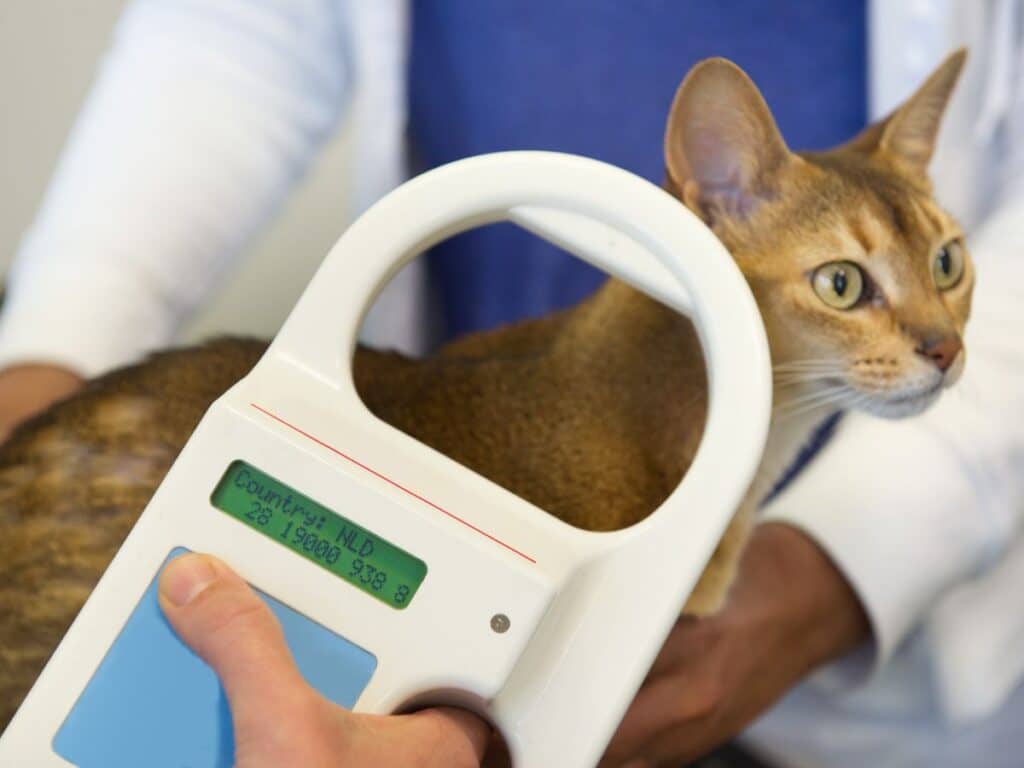Finding Out Pet’s Microchip Number
If you’re a pet parent wondering how to find your dog’s microchip number, you’ve come to the right place. Microchips are an incredibly useful tool that has helped reunite copious amounts of pets and pet owners. They are like your pet’s personal ID card, and they can be a lifeline if your dog gets lost or separated from you. But there’s one important catch – you need to know how to find your dog’s microchip number to make this technology work.
Knowing your pet’s microchip is registered with your up-to-date contact details could be the difference between a pet lost forever or not. Microchips are an essential part of pet relocation as they are the legal link between the pet and the documents, it’s how we prove the paperwork relates to that individual pet.
How to Search for Your Dog’s Microchip Number?
Searching for your dog’s microchip number is an essential step to ensure your pet’s safety and well-being. But in order to reunite with your lost pet, you need to find their unique microchip number. To find your pet’s microchip number, you can look at the following places including:
1. A certificate from the database in which your pet’s number is stored
When a veterinarian implants a microchip in your dog, they will register it with a pet recovery database that stores the unique identification number along with your contact information. This database stores your ownership information along with your pet’s microchip number. This certificate is a confirmation that your pet’s microchip is registered in their system.
2. Your vet’s records of your pet
If you ever lose or forget the microchip number, contacting your vet clinic can help you find your dog’s microchip number. Vets often keep the unique identification number in their animal’s medical records along with the microchip company and the date it was placed. Also, the vets will use microchip scanners to check your dog’s microchip.
3. On your pet’s passport (if applicable)
Many countries, including EU countries, require dogs to have a microchip implant and a pet passport for international travel. This passport contains your dog’s microchip number as part of their official identification information. So, if your dog has a passport, don’t forget to store it in a safe place, as it can help you find your dog’s microchip number.
4. On your pet’s insurance documents
Your pet’s insurance documents can provide an easy way to find your dog’s microchip number if needed. When you sign up for pet insurance, the company will likely request your dog’s microchip number as part of their identification details. This 15-digit ID code will then be included on your insurance policy paperwork and in your pet’s profile. So, if you are trying hard to search for your dog’s microchip number, take a loook at the pet’s documents e.g. vaccine card, licences, insurance etc, where the pet’s microchip number will be recorded.
Remember there can be different types of Pet Microchips, for example in Hong Kong we have the AVID type that is linked to the Hong Kong dog license and is required to move to Hong Kong or keep a dog in Hong Kong. Also, there is the ISO chip or international microchip, used internationally.
What to Do If You Cannot Find Your Dog’s Microchip Number
Losing your dog’s microchip number can be a stressful situation, but don’t panic. If you have no luck finding your dog’s microchip number through the above documents, then you can also do the following:
1. Contact the database that your pet’s number is stored in
For this, you will usually need either names, addresses or phone numbers to search the database with. Make sure you use the information that would have been inputted when you first registered your pet’s microchip.
2. Contact whoever carried out the procedure, if not your normal vet
If you don’t remember where your pet was microchipped, contacting the vet or clinic that initially performed the procedure can provide a way to find your pet’s microchip number. Even if it wasn’t your regular vet who implanted the chip, the clinic should have documented your dog’s unique microchip number in their records along with the registration details.
3. Take your pet to be scanned at your local vet, dog warden or rescue centre
If you can’t find your pet’s microchip number in any documents or veterinary records, you can take your pet to be scanned at a local vet, dog warden, or rescue centre. They can use a microchip scanner to detect if a microchip is present and read the unique 15-digit number. Hence, the microchip scanner is a big help in the process of your dog’s microchip search.
How Does a Pet Microchip Scanner Work?
A pet microchip scanner is a handheld device designed to detect and read microchips implanted in pets. When scanning, it’s positioned near the pet’s neck to locate the microchip, which it can detect from a distance of 3 to 8 cm using radio frequency identification (RFID) technology.
The microchip itself is a passive RFID tag, meaning it’s inactive within the animal and doesn’t have its own power source. RFID technology operates through radio waves to transmit data. The scanner emits electromagnetic waves to energize the microchip. Once energized, the microchip responds by sending radio signals back to the scanner. The scanner then displays the unique identification number associated with the microchip, enabling pet identification.
Is There a Pet Microchip Scanner App?
No, you can’t use a smartphone app to scan a pet’s microchip. Microchips utilize NFC (near-frequency communication) technology, which requires a specialized chip reader or scanner to detect the implanted number. Therefore, you’ll need assistance from a veterinarian or animal shelter to accurately scan a pet’s microchip for identification purposes.
Updating Your Pet’s Microchip Details
Depending on the database your pet’s chip is registered to, you can usually search the pet’s microchip number and see the contact information that is being held on it. You can then contact the database and ask for your details to be updated. Beware, this may come at a cost. Checking and regularly updating your pet’s microchip details is an extremely important habit to get into and really does make the difference to being reunited with your pet if it is ever to go missing.
In Hong Kong, the only real database is the AFCD record of microchips, which need to be correct and up to date for export.
Conclusion
As a pet relocation company, we understand the importance of having your pet’s microchip number readily available. Your dog’s microchip is a great help for identifying and reuniting with them if they ever become lost. We hope this article has helped you how to find your dog’s microchip number.
At Ferndale Kennels and Cattery, we also can help with pet microchip services, travel vet services, and full door-to-door shipping services. Feel free to phone us at +85227919330 or email us for any further explanations.
Click Here For Shipping Enquiry
Frequently Asked Questions
What is a microchip, and why is it important for my dog?
A microchip is a small, implantable device that contains a unique identification number for your dog. It's important for reuniting lost or missing pets with their owners.
What if I don’t have any paperwork with my dog’s microchip number on it?
If you don't have any paperwork with your dog's microchip number, you can contact the microchip company, search online registries, or have your vet scan your dog's microchip to detect the number.
Can I locate my dog’s microchip number using a scanner at home?
Home scanners are available, but it's recommended to have your dog scanned by a professional, such as your veterinarian or a local animal shelter.
What is the importance of updating my pet’s microchip information?
Keeping your pet's microchip information up-to-date is essential because it ensures that you can be contacted if your lost pet is found.
How to check microchip number if my dog was microchipped by a previous owner?
You can still search online databases or have your dog scanned to pick up the existing microchip number.






